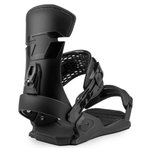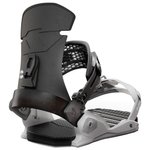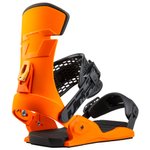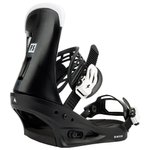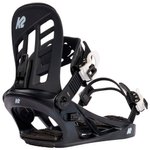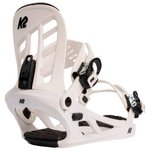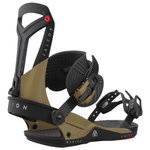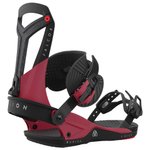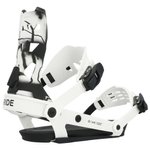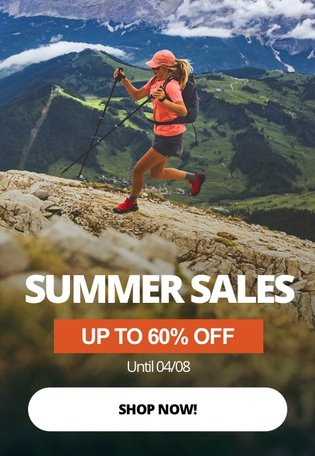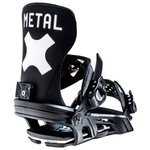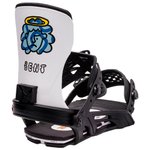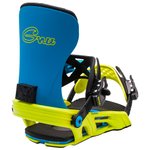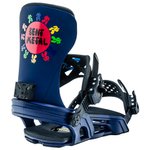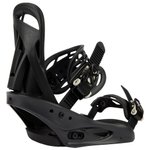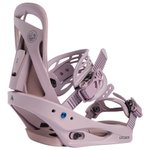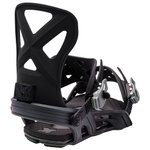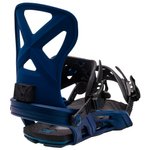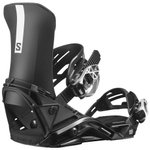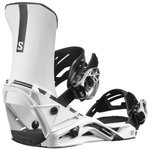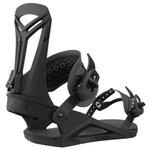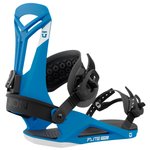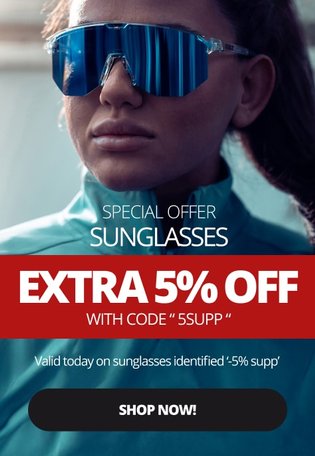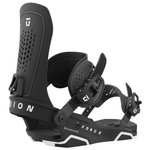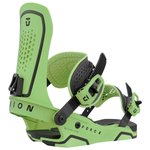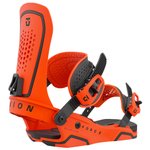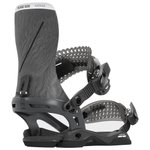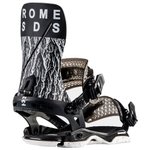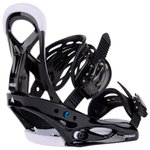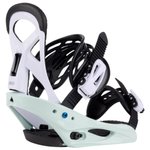Strap-in snowboard bindings
Have it your way with Strap-in bindings!
Strap in bindings are usually very customisable. From adjustable highback, heelcup, forward lean, canting, straps and more, you can tweak it as you like to get the ultimate fit and feel. This type of bindings have been around for ages, they're super durable and reliable.
Read more Show less

- £181.91
The Drake Fifty Black snowboard binding is a playful, enjoyable to ride and versatile model allowing to have a blast in the entire resort in freestyle and shred on any side hits!
- M (36-41)
- L (41-43.5)
- XL (43.5-48.5)


Recommended price
£181.91
-30%
£127.31
The Burton Freestyle Black is a simple and easy to ride snowboard binding that allows you to start snowboarding and progress throughout the resort.
- S (38-41)
- M (41-44)
- L (43-48)


- £95.55
The K2 Mini Turbo is a lightweight, durable snowboard binding for young riders, offering maximum comfort, easy tool-less adjustments, ideal for learning and making your first turns.
- XS (29-32.5)
- S (33-36)


Recommended price
£218.31
-35%
£141.87
The Verdad Pro Binding is a versatile, high-quality snowboard binding offering comfort, responsiveness, ideal for intermediate to advanced riders.
- S (35-40)
- M (40-44)
- L (43-47)


Recommended price
£145.51
-40%
£86.36
The YOU+H Black is a children’s snowboard binding designed by K2, which offers a perfect balance of support, forgiveness and comfort, allowing youngsters to progress.
- M (36-40)


Recommended price
£336.61
-15%
£286.10
The Union Falcor snowboard binding is a high-performance model designed for advanced or expert riders seeking precision, responsiveness, and comfort in freeride or backcountry freestyle.
- M (41-43)


Recommended price
£345.71
-30%
£241.97
The Ride A-8 is a versatile, high-performance snowboard binding offering precision, responsiveness, comfort, and cushioning on all terrains.
- M (37-43.5)
- L (43.5-50)


Recommended price
£263.81
-30%
£184.64
The Axtion by Bent Metal is a versatile, comfortable, and responsive snowboard binding, offering a balance of power, support, and freedom of movement for advanced snowboarders.
- S (37-40.5)
- M (40.5-45)
- L (45-48.5)


Recommended price
£282.01
-30%
£197.38
The Axtion by Bent Metal is a versatile, comfortable, and responsive snowboard binding, offering a balance of power, support, and freedom of movement for advanced snowboarders.
- M (40.5-45)
- L (45-48.5)


Recommended price
£181.91
-30%
£127.31
The Citizen Black women's snowboard binding from Burton is a flexible and forgiving model designed for learning to snowboard and for intermediate snowboarders.
- S (34-36.5)


Recommended price
£181.91
-30%
£127.31
- S (34-36.5)


Recommended price
£327.59
-30%
£229.23
- M (40.5-45)
- L (45-48.5)


- £272.91
The District White from Salomon is a freestyle-oriented snowboard binding. Its flexible and playful construction is designed to land tricks in the terrain park.
- L (43.5-47)


Recommended price
£154.61
-35%
£100.01
The Union Flite Pro: Lightweight, forgiving, and friendly snowboard bindings ideal for beginner and intermediate level snowboarders to progress and have fun.
- S (37-40.5)
- M (41-43)


Recommended price
£291.11
-20%
£232.87
The Union Force snowboard binding offers a good balance between responsive and forgiveness, to satisfy a wide range of snowboarders looking for performance and riding comfort.
- L (43.5-46)


Recommended price
£291.15
-20%
£231.96
The Union Force snowboard binding offers a good balance between responsive and forgiveness, to satisfy a wide range of snowboarders looking for performance and riding comfort.
- L (43.5-46)


Recommended price
£291.11
-20%
£231.96
The Union Force snowboard binding offers a good balance between responsive and forgiveness, to satisfy a wide range of snowboarders looking for performance and riding comfort.
- L (43.5-46)


Recommended price
£291.11
-20%
£231.96
The Union Force snowboard binding offers a good balance between responsive and forgiveness, to satisfy a wide range of snowboarders looking for performance and riding comfort.
- L (43.5-46)


Recommended price
£363.91
-30%
£254.71
The Rome Katana is a versatile, high-end snowboard binding, offering adjustable settings, robust construction, and responsive power transfer for advanced and expert level snowboarders.
- S (36.5-40.5)


Recommended price
£163.71
-36%
£104.56
The Burton Kids' Smalls black is a versatile, lightweight snowboard binding offering comfort, stability, and advanced technology for young beginner to intermediate riders.
- L (35-40)


Recommended price
£163.71
-36%
£104.56
The Burton Kids' Smalls Neo-Mint White is a lightweight, versatile snowboard binding, offering comfort, stability, and advanced technology for young beginner to intermediate riders.
- L (35-40)
INCLUDED
DAY RETURNS
Fixed costs
Loading...
How to choose your classic snowboard binding?
If the price and the color of a snowboard binding are criteria that anyone who is not familiar with snowboarding is able to appreciate, other more specific points are to be taken into consideration before jumping on the most beautiful and cheapest binding.
Choosing a binding adapted to my level
A beginner does not use the same type of binding as an expert, and this is certainly the most important thing to consider. It is better to be humble and choose a binding adapted to your level that will bring you comfort and allow you to progress, rather than an over-performance binding that will exhaust you and prevent you from enjoying your descents.
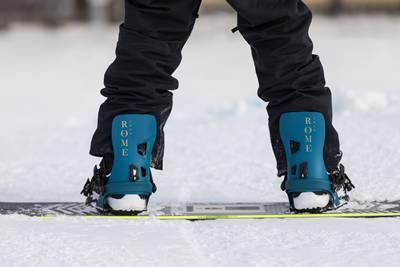
To help you in your choice, we classify the bindings by level (beginner - intermediate, intermediate - advanced, advanced - expert). The main criterion that motivates us to classify a binding in one category rather than another is its rigidity. The more rigid a binding is, the more precise and powerful it can be in the supports. On the other hand, it is more tiring and leaves less room for error. This is why we direct you towards flexible and comfortable bindings if you are a beginner and, the more you go up in level, the more rigid and powerful bindings we offer you.
Attention, these rankings are indicative and should be put into perspective with your experience and your feeling. Even with a very good level and many years of riding, some snowboarders do not like bindings that are too rigid, whether for reasons of feeling or size. The only certainty is that a beginner will not like a binding that is too rigid.
Choosing a binding adapted to my practice
Stiffness is not the only point of vigilance and, what's more, it is a parameter that varies according to one's practice and preferences. Snowboarding is divided into several sub-disciplines (freestyle, freeride, all-mountain, carving, boardercross, ...) and is practiced on different terrains (piste, off-piste, snowpark, street, backcountry, high mountain, ...). The binding you choose will also depend on what you like to do with your snowboard.
That's why at Glisshop we classify the bindings according to four programs: freestyle/park, freeride, versatile freestyle, versatile freeride.
The freestyle/park bindings are for freestyle/jib enthusiasts in snowpark or street. They are generally more flexible and focus on comfort and playability. Spoilers are short and flat enough to offer good lateral freedom of movement.
Freeride bindings rely on precision and control to allow you to ride fast and strong in all circumstances. This is achieved by using torsionally stiff materials and a spoiler that rides high and wraps well around the calf.
Versatile bindings appeal to the widest range of snowboarders, those who like to do it all. Rather freestyle or freeride oriented depending on the model, they offer a good compromise between freedom of movement and precision. The difference is sometimes quite fine and subjective between a freestyle all-rounder and a freeride all-rounder.
Once again, this ranking is an aid to the choice that does not necessarily have to be followed to the letter. Each snowboarder's needs are different, so you must first of all deal with your own feelings and experience.

